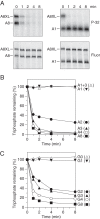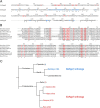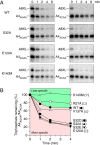Specificity and evolutionary conservation of the Escherichia coli RNA pyrophosphohydrolase RppH
- PMID: 25657006
- PMCID: PMC4392253
- DOI: 10.1074/jbc.M114.634659
Specificity and evolutionary conservation of the Escherichia coli RNA pyrophosphohydrolase RppH
Abstract
Bacterial RNA degradation often begins with conversion of the 5'-terminal triphosphate to a monophosphate by the RNA pyrophosphohydrolase RppH, an event that triggers rapid ribonucleolytic attack. Besides its role as the master regulator of 5'-end-dependent mRNA decay, RppH is important for the ability of pathogenic bacteria to invade host cells, yet little is known about how it chooses its targets. Here, we show that Escherichia coli RppH (EcRppH) requires at least two unpaired nucleotides at the RNA 5' end and prefers three or more such nucleotides. It can tolerate any nucleotide at the first three positions but has a modest preference for A at the 5' terminus and either a G or A at the second position. Mutational analysis has identified EcRppH residues crucial for substrate recognition or catalysis. The promiscuity of EcRppH differentiates it from its Bacillus subtilis counterpart, which has a strict RNA sequence requirement. EcRppH orthologs likely to share its relaxed sequence specificity are widespread in all classes of Proteobacteria, except Deltaproteobacteria, and in flowering plants. By contrast, the phylogenetic range of recognizable B. subtilis RppH orthologs appears to be restricted to the order Bacillales. These findings help to explain the selective influence of RppH on bacterial mRNA decay and show that RppH-dependent degradation has diversified significantly during the course of evolution.
Keywords: Nudix; Proteobacteria; RNA Degradation; RNA Modification; RNA Turnover; RNA-Protein Interaction; mRNA Decay.
© 2015 by The American Society for Biochemistry and Molecular Biology, Inc.
Figures








Similar articles
-
Structures of RNA complexes with the Escherichia coli RNA pyrophosphohydrolase RppH unveil the basis for specific 5'-end-dependent mRNA decay.J Biol Chem. 2015 Apr 10;290(15):9487-99. doi: 10.1074/jbc.M114.634824. Epub 2015 Feb 5. J Biol Chem. 2015. PMID: 25657011 Free PMC article.
-
The bacterial enzyme RppH triggers messenger RNA degradation by 5' pyrophosphate removal.Nature. 2008 Jan 17;451(7176):355-8. doi: 10.1038/nature06475. Nature. 2008. PMID: 18202662
-
Importance of a diphosphorylated intermediate for RppH-dependent RNA degradation.RNA Biol. 2018;15(6):703-706. doi: 10.1080/15476286.2018.1460995. Epub 2018 May 29. RNA Biol. 2018. PMID: 29619898 Free PMC article.
-
RNase P RNA of Mycoplasma capricolum.Mol Biol Rep. 1995-1996;22(2-3):125-9. doi: 10.1007/BF00988716. Mol Biol Rep. 1995. PMID: 8901498 Review.
-
Maturation and degradation of RNA in bacteria.Curr Opin Microbiol. 2007 Jun;10(3):271-8. doi: 10.1016/j.mib.2007.05.008. Epub 2007 Jun 7. Curr Opin Microbiol. 2007. PMID: 17560162 Review.
Cited by
-
Noncanonical features and modifications on the 5'-end of bacterial sRNAs and mRNAs.Wiley Interdiscip Rev RNA. 2019 Mar;10(2):e1509. doi: 10.1002/wrna.1509. Epub 2018 Oct 1. Wiley Interdiscip Rev RNA. 2019. PMID: 30276982 Free PMC article. Review.
-
Stresses that Raise Np4A Levels Induce Protective Nucleoside Tetraphosphate Capping of Bacterial RNA.Mol Cell. 2019 Sep 5;75(5):957-966.e8. doi: 10.1016/j.molcel.2019.05.031. Epub 2019 Jun 6. Mol Cell. 2019. PMID: 31178354 Free PMC article.
-
Principles of RNA and nucleotide discrimination by the RNA processing enzyme RppH.Nucleic Acids Res. 2020 Apr 17;48(7):3776-3788. doi: 10.1093/nar/gkaa024. Nucleic Acids Res. 2020. PMID: 31960065 Free PMC article.
-
Identification of the RNA Pyrophosphohydrolase RppH of Helicobacter pylori and Global Analysis of Its RNA Targets.J Biol Chem. 2017 Feb 3;292(5):1934-1950. doi: 10.1074/jbc.M116.761171. Epub 2016 Dec 14. J Biol Chem. 2017. PMID: 27974459 Free PMC article.
-
A Novel RNA Phosphorylation State Enables 5' End-Dependent Degradation in Escherichia coli.Mol Cell. 2017 Jul 6;67(1):44-54.e6. doi: 10.1016/j.molcel.2017.05.035. Epub 2017 Jun 29. Mol Cell. 2017. PMID: 28673541 Free PMC article.
References
-
- Baker K. E., Mackie G. A. (2003) Ectopic RNase E sites promote bypass of 5′-end-dependent mRNA decay in Escherichia coli. Mol. Microbiol. 47, 75–88 - PubMed
-
- Deana A., Celesnik H., Belasco J. G. (2008) The bacterial enzyme RppH triggers messenger RNA degradation by 5′ pyrophosphate removal. Nature 451, 355–358 - PubMed
Publication types
MeSH terms
Substances
Grants and funding
LinkOut - more resources
Full Text Sources
Molecular Biology Databases

